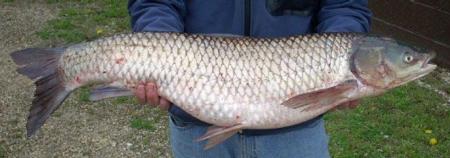Grass Carp
-
Scientific Name
Ctenopharyngodon idella - Visit ITIS for full scientific classification.
-
Description
 Grass Carp. Konrad Schmidt. © 2008 Regents, University of California
Grass Carp. Konrad Schmidt. © 2008 Regents, University of California- Large, freshwater fish.
- Elongated body, with a wide scale-less head.
- Olive brown color on back, silvery sides, white to yellow belly, dark fins, and a gray head.
- Scales are large with dark edges. Long, serrated teeth in throat for chopping and grinding aquatic vegetation.
- Sexually mature at about 2 feet and 10 pounds, but not uncommon for them to reach lengths greater than 3 feet long, and weigh over 60 pounds.
- Possible for individuals to reach nearly 100 pounds.
- Because they aggressively eat aquatic plants, they are sometimes used for weed control. If sighted, find out if they were placed there.
-
Habitat
- Commonly found in shallow areas of rivers, but also found in quiet waters of ponds, irrigation canals, and lakes.
- Grass Carp can tolerate extreme environmental conditions including: low oxygen levels, brackish water, and temperatures ranging from 32-100 degrees F.
-
Invasion Pathways and Distribution
- In 1963, Grass Carp were introduced to control aquatic plants in a fish farm in Arkansas.
- They spread from the Arkansas River to the Mississippi River, and are now found and continue to spread throughout the U.S.
- Asian Carp can spread through fish farming activities, legal and illegal stocking, accidental inclusion in shipments, escape or release to open waters, and natural dispersal.
- Native to China and Russia.
- See USGS for a map of current U.S. distribution.
-
Life History
- Mating season begins in the summer when the water is warmer than 65 degrees F.
- Females migrate to areas of moderate water flow in order to release their eggs into the water column.
- Enormous reproductive capabilities.
- Possible for females to release over 1 million eggs in a single season.
-
Impacts
- Compete with native fishes for resources.
- Aggressively eats aquatic plants, which physically alters habitat.
- Habitat changes affect native fishes, birds and invertebrates.
- If aquatic plants are not around they will dig in sediment causing bank erosion, impacting the habitat for native species.
- Grass Carp can also carry diseases that can spread to native fishes.
-
References and Useful Links
For references by category and links to other useful AIS sites see our LEARN MORE page.

